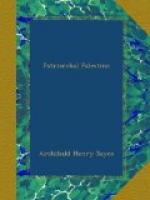The Damascus of to-day stands on the site of the city from which St. Paul escaped, and “the street which is called Straight” can still be traced by its line of Roman columns. But it is doubtful whether the Damascus of the New Testament and of to-day is the same as the Damascus of the Old Testament. Where the walls of the city have been exposed to view, we see that their Greek foundations rest on the virgin soil; no remains of an earlier period lie beneath them. It may be, therefore, that the Damascus of Ben-Hadad and Hazael is marked rather by one of the mounds in the plain than by the modern town. In one of these the stone statue of a man, in the Assyrian style, was discovered a few years ago.
An ancient road leads from the peach-orchards of Damascus, along the banks of the Abana and over Anti-Lebanon, to the ruins of the temple of the Sun-god at Baalbek. The temple as we see it is of the age of the Antonines, but it occupies the place of one which stood in Heliopolis, the city of the Sun-god, from immemorial antiquity. Relics of an older epoch still exist in the blocks of stone of colossal size which serve as the foundation of the western wall. Their bevelling reminds us of Phoenician work.
Baalbek was the sacred city of the Bek’a, or “cleft” formed between Lebanon and Anti-Lebanon by the gorge through which the river Litany rushes down to the sea. Once and once only is it referred to in the Old Testament. Amos (i. 5) declares that the Lord “will break the bar of Damascus and cut off the inhabitant from Bikath-On”—the Bek’a of On. The name of On reminds us that the Heliopolis of Egypt, the city of the Egyptian Sun-god, was also called On, and the question arises whether the name and worship of the On of Syria were not derived from the On of Egypt. For nearly two centuries Syria was an Egyptian province, and the priests of On in Egypt may well have established themselves in the “cleft” valley of Coele-Syria.
From Baalbek, the city of “Baal of the Bek’a,” the traveller makes his way across Lebanon, and under the snows of Jebel Sannin—nearly 9000 feet in height—to the old Phoenician city of Beyrout. Beyrout is already mentioned in the cuneiform tablets of Tel el-Amarna under the name of Beruta or Beruna, “the cisterns.” It was already a seaport of Phoenicia, and a halting-place on the high road that ran along the coast.
The coastland was known to the Greeks and Romans as Phoenicia, “the land of the palm.” But its own inhabitants called it Canaan, “the lowlands.” It included not only the fringe of cultivated land by the sea-shore, but the western slopes of the Lebanon as well. Phoenician colonies and outposts had been planted inland, far away from the coast, as at Laish, the future Dan, where “the people dwelt careless,” though “they were far away from the Sidonians,” or at Zemar (the modern Sumra) and Arka (still called by the same name). The territory of the Phoenicians stretched southward as far as Dor (now Tanturah), where it met the advance guard of the Philistines.




